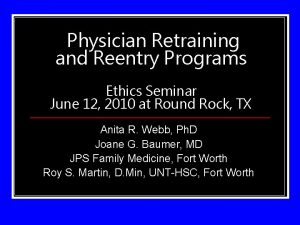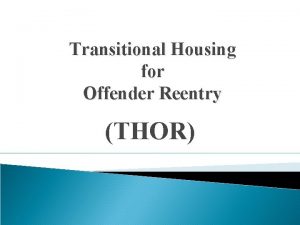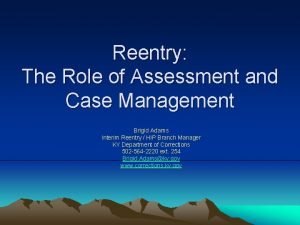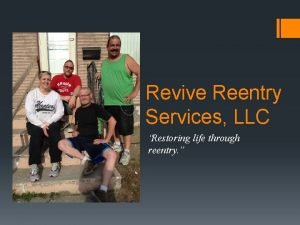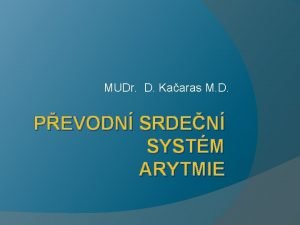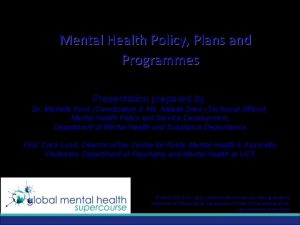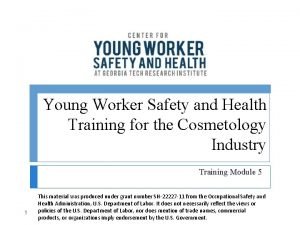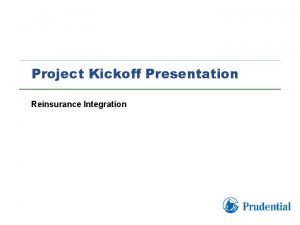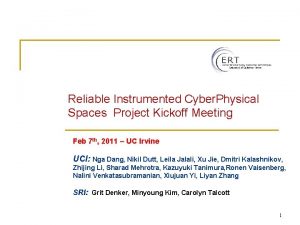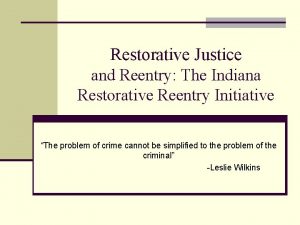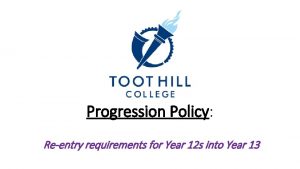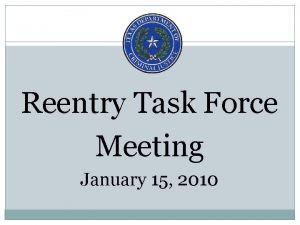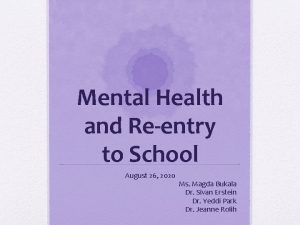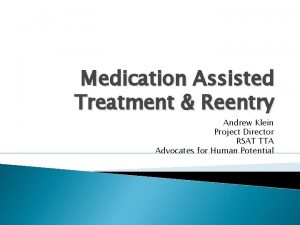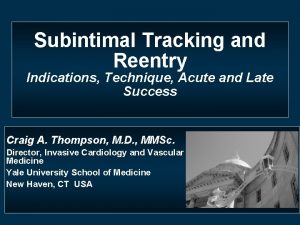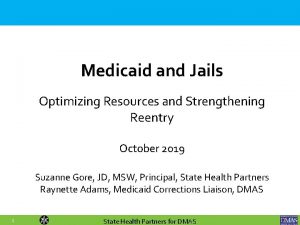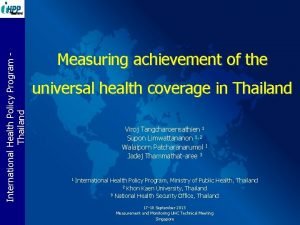Reentry Health Policy Project Meeting the Health and






























- Slides: 30

Reentry Health Policy Project: Meeting the Health and Behavioral Health Needs of Prison & Jail Inmates Returning From Custody to their Community January 2018

Overview • • Objective: Identify state and county-level policies and practices that impede the delivery of effective health and behavioral health care services to people who are reentering their communities following incarceration in prison or jail; and find best practices that can be replicated at the state and local level. Funding has been provided by the California Health Care Foundation and L. A. Care. Medically Fragile (MF) and Individuals with Serious Mental Illness (SMI). The project has focused health and behavioral health issues of MF and SMI inmates as they return from custody to their communities. Focus Areas: California Department of Corrections and Rehabilitation (CDCR), and three counties: San Diego, Los Angeles, and Santa Clara. 2

Issues Identified Based on input from policymakers, practitioners, and stakeholders, seven issue areas were identified and became the focus of the report: • • Eligibility Establishment to help reduce the structural barriers that hinder an individual’s ability to receive care based on insurance status at the time of their release. Care Coordination and Service Delivery to reduce barriers to a smooth transition into county level care post-incarceration. Maximizing Federal Financial Participation (FFP) to open up funding opportunities available primarily due to the Affordable Care Act. Release of Information (ROI) to facilitate client data sharing across agency to promote communication and collaboration from the state to the county levels. Residential and Outpatient Treatment Capacity for Individuals with Co. Occurring Disorders (CODs) to ensure an adequate supply of qualified service providers, licensing, and certifications. Housing for SMI and MF reentry populations. Evaluation of programs and services for people in reentry. 3

The Evolving Landscape at the Intersection of Criminal Justice and Health 4

A growing portion of the criminal justice population has physical and mental health problems. • • California’s criminal justice system includes around 200, 000 people who are incarcerated and more than 400, 000 who are under community supervision. About 36, 000 people were released from California prisons annually over the past decade, and over a million people admitted and released from jails, with many cycling through the criminal justice system multiple times in a given year. Criminal justice populations are characterized by high rates of physical and mental health problems. A Washington State study in 2007 found risk of death was almost 13 times higher former inmates in the two weeks following their release compared to the general population. Health and medical costs now form a major part of most corrections budgets, totaling about a fifth of all corrections expenditures nationwide and 31% in California. The “greying” prison population (age 50+) is growing and are far more costly to incarcerate compared to younger cohorts, and prisons and jails are among the most expensive places to deliver care. State Prison population over 50 yearsold grew from 4% to 21% between 1990 and 2013. 5

Historic reforms have transformed criminal justice processes in California. 2011: AB 109 – Public Safety Realignment • Transfer of responsibility of “non-nons” from the State to counties; Post-Release Community Supervision (PRCS) supervised by Probation. 2012: Proposition 36 – The Three Strikes Reform Act • Limited the imposition of third strikes to serious/violent offenses. Authorized resentencing for less serious/nonviolent third strikers. 2014: Proposition 47 – The Reduced Penalties for Some Crimes Initiative • Reduced seriousness of certain lower-level drug and property offenses. Many could apply for early release. 2016: Proposition 57 – The • Expanded eligibility criteria and opportunities to earn California Parole for Nonviolent sentence credit for good behavior and rehabilitative Criminals and Juvenile Court Trial program participation. Requirements Initiative 6

…But Prison and Jails Are Still Crowded The CDCR. • Recent reforms resulted in a reduction of the prison population by about 50, 000 people. However, the Legislative Analyst’s Office reports that the CDCR’s prison capacity is currently 117, 000 (137. 5% of design capacity), only about 2, 000 beds above the current prison population. Jails. • In 2016, the average daily jail population (ADP) in California jails was about 72, 000 people, about 36% of whom had already been sentenced. • About 1. 1 million admissions to jails in 2014. Average length of stay in 2012 was 21 days, though most are far shorter. 7

Defining SMI and MF Inmates • • Serious Mental Illness (SMI) is discussed here as a mental disorder that is severe in degree and persistent in duration, causes behavioral functioning that interferes substantially with the primary activities of daily living, and may result in an inability to maintain stable adjustment and independent functioning without treatment, support, and rehabilitation for a long or indefinite period of time. Medically Fragile (MF). There is no consistent term that jails and state prisons use to identify and track inmates with serious and chronic health conditions. We have used the term “medically fragile” in our report to generally refer to individuals with acute or chronic health problems that require ongoing therapeutic intervention and/or skilled nursing care during all or part of the day. 8

How Many SMI Inmates are in CDCR? Housing Classifications for People with Diagnosed Mental Illness by Release Type (2015) PRCS Parole Total Releases 18, 281 18, 654 Total Mentally Ill Releases 3, 520 (18. 8%) 4, 320 (22. 6%) Department of State Hospitals Intermediate Care Facility (DSH-ICF 36 (. 2%) 58 (. 3%) Acute Inpatient Hospital Care 16 (. 1%) 75 (. 4%) Mental Health Crisis Beds (MHCBS) 41 (. 2%) 55 (. 3%) Enhanced Outpatient Program (EOP) 442 (2. 4%) 868 (4. 7%) Correctional Clinical Case Management System (CCCMS) 2, 985 (16. 3%) 3, 264 (17. 5%) • (Longer term mental health inpatient treatment) • (Severe psychosis. Treatment provided by contract with DSH) • (Require 24 -hour nursing care) • (Unable to function in general prison population) • (Exhibit symptom control or in remission; able to function in general prison population) 9

How Many SMI Inmates are in Jail? No consistent statewide definition, but most counties report the number of those receiving psychotropic medication(s). Mar 2012 to Feb 2013 Mar 2014 to Feb 2015 Mar 2016 to Feb 2017 Mar 2012 to Feb 2017 # on Psych Meds Annua l ADP % on Psych Meds % Change in # on Psych Meds Los Angeles 2, 667 17, 700 15% 2, 774 17, 930 16% 3, 373 16, 145 21% 26% Santa Clara 607 3, 667 17% 574 4, 026 14% 708 3, 568 20% 17% San Diego 1, 055 5, 150 20% 1, 353 5, 498 25% 1, 308 5, 457 24% State Sample (45 counties) 10, 999 70, 101 16% 12, 112 71, 373 18% 13, 776 67, 384 20% 25% Source: BSCC JPS Online Query & Author Calculations 10

How Many Medically Fragile Inmates are in Prison and Jails? • • No statewide commonly used definitions or data. • Counties report similar numbers. Los Angeles County, for example, houses around 245 people with complex medical needs per month. San Diego County Jail identified 658 inmates as having prescriptions for more than five medications for either medical or psychiatric needs, translating to around 12% of the jail’s ADP. State Prisons: 5, 526 medically fragile inmates were in custody as of March 2017, according to CDCR. In 2016, 638 MF inmates were released from CDCR facilities. This represents about 1. 7% of total releases. More than half (54%) of this group had ten or more prescription medications. 95 people required placement in a hospital or Skilled Nursing Facility (SNF) upon release. 11

Health & Social Policy Reforms Provide New Opportunities for Health & Behavioral Health Treatment • • • The Affordable Care Act (ACA) expanded Medi-Cal coverage to low-income childless adults. Federal funding initially provided 100% of cost of coverage, phasing down to 90% in 2020. The Mental Health Services Act (MHSA) passed as Proposition 63 in 2004, generates about $2 billion for the support of specialty mental health services. The MHSA addresses a broad continuum of prevention, early intervention, and service needs as well as providing funding for infrastructure, technology, and training for the community specialty mental health system. In 2014, California enacted legislation to provide mental health services for Medi-Cal eligible individuals with mild and moderate mental health needs. This was a new benefit for Medi. Cal beneficiaries that did not exist prior to the Affordable Care Act. 12

The Department of Health Care Services’ (DHCS) initiatives to improve the delivery of Medi-Cal services to persons with complex health care needs: Whole Person Care (WPC) Pilots. Targeting vulnerable high utilizers of multiple systems, the Medi-Cal 2020 Waiver allocates $1. 5 billion, over five years, to counties that will match the funds to create pilot programs to demonstrate the effectiveness of coordinating physical health, behavioral health, and social services in a patient-centered manner. Four counties specifically target the reentry population. Public Hospital Redesign and Incentives in Medi-Cal (PRIME). The Waiver earmarks $3. 7 billion over the five years to improve the quality and value of care provided by California’s safety net hospitals and hospital systems. The program aims to develop a new paradigm for the organized delivery of health care services for Medicaid eligible individuals with a substance use disorder (SUD). Four projects focus on the post incarceration target population. The Drug Medi-Cal Organized Delivery System (DMC-ODS). Part of the Medi-Cal 2020 Waiver, the program aims to develop a new paradigm for the organized delivery of health care services for Medicaid eligible individuals with a substance use disorder (SUD). Health Home for Patients with Complex Needs (HHPCN) Provides six core services: comprehensive care management; care coordination (physical health, behavioral health, community-based LTSS); health promotion; comprehensive transitional care; individual and family support; and referral to community and social support services. The federal government provides 90% of the funding for the first two years, and 50% thereafter. Phased implementation beginning in July 2018. 13

Reentry Health Policy Project: Recommendations & Next Steps 14

1 A. Medi-Cal Eligibility Establishment CDCR is currently screening 100% of all inmates for benefit eligibility, and is providing benefit assistance services to 77. 6% of the inmate population prior to release. 27, 000 Medi-Cal applications were submitted in 2016 -17, with 85% approval prior to release. About 3, 600 applications were pending. Applications are faxed or mailed to county human services department. CDCR, DHCS and counties have regular meetings and process for improving the system. Recommendations: • Eliminate Eligibility Suspension Time Limit. The current one-year suspension of eligibility should be replaced by an indefinite suspension of benefits. That suspension would be removed on the date the inmate is no longer incarcerated or otherwise eligible. • The Potential for a Presumptive Eligibility Process. The DHCS and stakeholders in California should discuss and evaluate the possibility of establishing a short term presumptive eligibility period former inmates whose eligibility has not been determined at the point of release from incarceration. • Health Plan Selection: o State policy should be changed or clarified so that formerly incarcerated persons (FIPs) who have had their Medi-Cal eligibility suspended can remain in the health plan they were enrolled in prior to incarceration, so long as they are released to their county of last legal residence. o Prior to release from custody, individuals’ health plans should be informed of the date of release, efficient transfer of medical records should take place, and a PCP should be identified to ensure continuity of care where needed. o Inmates who did not have Medi-Cal eligibility prior to their incarceration, or who may require a new health plan, should complete their HCO applications concurrently with their eligibility application. 15

1 B. Supplemental Security Income (SSI) For 2016 -17, CDCR reported a 30% approval rate for the 3, 611 SSI applications. Recommendations: • Initiate Eligibility Establishment Sooner. Counties should consider initiating applications for those who can qualify on the basis of disability when the person enters the jail to increase the chances it is successfully completed. All county jails should take advantage of the materials and training available through the SOAR program. • Documenting the Disability. CDCR’s California Correctional Health Care Services (CCHCS) should consider conducting a workload analysis to evaluate the current timeline and staffing that supports the SSI application process and requests to SSA for disability evaluations. • Low SSI/SSDI Approval Rates. o The CDCR and SSA should include advocacy and other stakeholder organizations in their regular meetings, to review data on SSI eligibility determinations former inmates, and to discuss and resolve issues that have been encountered in submitting applications and securing approvals. o Jails. A forum should be held with representatives of several county jails to discuss the experience they have had in submitting SSI applications on behalf of their inmates, and to brainstorm possible approaches to improving application approval rates and processing times. 16

1 C. Cal. Fresh (Supplemental Nutrition Assistance or SNAP) CDCR’s pre-release planning process includes Cal. Fresh application, but benefits do not begin until a face-to-face meeting with county eligibility worker. New York, South Dakota, and Vermont have obtained their waivers and conduct SNAP pre-enrollment. Recommendations: • DSS should continue to seek the necessary authorization to request the preenrollment waiver, and work with CDCR and other stakeholders to determine whether the 30 day timeframe will be sufficient to process Cal. Fresh applications prior to release. Note: SB 708 (Skinner) was held on the suspense file in the Senate Appropriations Committee. • DSS should work with counties and other stakeholders to explore simplifications that could be implemented to expedite the Cal. Fresh enrollment process for persons reentering the community in order to ensure that benefits are available upon release. These proposed simplifications could be added to the Department’s federal waiver request if needed. 17

1 D. Obtaining a California ID Many inmates are leaving CDCR without a California ID or valid California Driver’s License. According to the DMV, about 85% of reentering inmates have a picture on file that meets the statutory requirement of being less than 10 years old. That suggests 15% require a new photograph. A 2017 survey of PRCS inmates conducted by LA County Probation found that only 37% had either a valid drivers’ license or Cal-ID. (See chart below. ) Recommendation: A more detailed review of the effectiveness of the ID issuance process is needed to determine the share of eligible applicants that are not able to get IDs and why. Additional discussion is needed to consider alternative options for providing access to IDs for those who do not meet the requirements of AB 2408, i. e. , establishing a process for initiating a new application (including photos and fees) for those with no prior record at the DMV. Cal-ID Status of Individuals Released to LA County on Post Release Community Supervision in June 2016 Valid California Driver’s License 10% Valid California ID Number 27% Expired CDL 44% No CDL or ID 12% No Information 7% Source: Survey results from LA County Probation Department, 2017 18

2. Care Coordination and Service Delivery A. Transitions Between Systems & Programs Individuals released from prison and jail face challenges in maintaining continuity of care, and coordination of health and behavioral health services – including transfer of health are records. • Program Cliffs – need for “warm hand-offs” as responsibility shifts between probation/parole, county behavioral health, and health services (e. g. : CDCR inmates who require SNF level care in the community). • Primary Care “Carve outs” for specialty mental health, substance abuse treatment, and dental services • Siloed Funding (e. g. , do county behavioral health programs serve parolees? ) Medi-Cal managed care plans can support coordination. Arizona, Colorado , Florida & Ohio require their plans to do in-reach for prison and jail inmates, and provide coordination for inmates with complex health needs. Whole Person Care Pilots also have promise. Recommendations: • Help CDCR develop a Statewide Protocol for Transitioning MF inmates. Bring together CDCR’s Health Services and Medi-Cal managed care plans – perhaps beginning with County Organized Health System Plans • Facilitate Reentry Learning Collaborative for Whole Person Care pilots & PRIME to share information and experience. • Improve State/County coordination for SMI Parole Programs. Council of Mentally Ill Offenders (COMIO) could facilitate process. 19

2. Care Coordination and Service Delivery (continued) B. Provider Approach to Service Delivery & Unique Patient Needs Health and behavioral health providers face unique challenges in serving the reentry population, including: stigma, fear of the “system, ” trauma and gender issues, and inexperience with taking personal responsibility for managing care. Community Health Workers (CHW’s) with shared life experiences can help former inmates navigate the system. Recommendation: • Take CHWs approach to Scale. This could include integration with, and funding through Medi-Cal managed care plans, security clearance access to prison and jails, and specialized training 20

Toward a Comprehensive Model of Integration Using Medi-Cal Managed Care Plans Recommendation: Consider development of a comprehensive model for coordinating care of transitioning prison and jail inmates. Elements include: • Specialized Provider Network. Recognizing the unique needs of justice-involved population, Medi-Cal managed care plans could create a specialized provider network, mostly likely relying on specific FQHC’s. (Note: Inland Empire Health Plan has a specialized network for children in foster care. ) • Community Health Workers. Contracts with FQHC’s could include funding for CHWs who could be part of the clinical team meeting health and behavioral health needs. • Probation/Parole Engagement. Coordination of care should also include probation officers and parole agents. • Supplemental County Incentive Funding. Counties have an incentive to provide resources to this collaborative if recidivism to jail is reduced. Local funding could be used to provide incentive payments to providers to pay for additional costs. • Data Sharing and Performance Metrics. This model requires robust data sharing and should include performance measures. 21

3. Maximizing Federal Financial Participation (FFP) A. Maximizing FFP for Medicaid Administrative Activities (MAA). Federal funds can be claimed for services to Medi-Cal eligible individuals for health related administrative services such as: Medi-Cal enrollment, referral to a covered health service, transportation to a covered health service, contract administration, and planning. Recommendations: • Assess interest from statewide associations, including the Chief Probation Officers of California (CPOC), California Sheriff’s Association, and the Administrative Office of the Courts (AOC), for hosting presentations. • • Explore potential options for MAA claiming with CDCR. Ask DHCS to consider requesting CMS to clarify the claiming rules relating to MAA to: (1) broaden the definition of administrative activities so that it can also includes, pre-release planning activities associated with post-release care coordination and not only eligibility assistance; (2) expand the 30 -day window prior to release to reflect the need to begin these administrative activities earlier. 22

3. Maximizing Federal Financial Participation (FFP) (continued) B. Obtaining FFP for Dispensing a 30 -Day Supply of Medication Upon Release. To ensure continuity of drug therapy, CDCR provides a 30 day supply of medication upon release of inmate. Jail approaches vary, often providing a prescription for the former inmate to pick up at a local pharmacy. In both cases, there are opportunities for maximizing FFP. Recommendations: • CDCR should explore option of obtaining FFP for Medi-Cal eligible inmates who receive 30 day supply of medication. • Jails should consider potential workarounds to allow a jail-based pharmacy to provide medication for inmates who are being released in lieu of building a new pharmacy outside the jail walls. 23

3. Maximizing Federal Financial Participation (FFP) (continued) Maximizing FFP for Parolee SMI Services. During FY 2016 -2017, the state spent about $31. 5 million for the CDCR’s Mental Health Services Continuum Program. (See below. ) Major Parolee Programs for those living with SMI Program 2016 -17 Budget Parole Outpatient Clinics (POCs) $16. 5 m Integrated Services for Mentally Ill Parolees (ISMIP) $12. 3 m Case Management Reentry Program (CMRP) $2. 7 m CDCR has interagency agreement with Santa Clara County and San Francisco for the ISMIP program that allows some state funds to be matched. Recommendation: • Support efforts by the Council of Mentally Ill Offenders (COMIO) to help facilitate discussions with state and local corrections officials and county specialty mental health leaders to develop policy recommendations for improving services to SMI justice-involved individuals. Suggest the establishment of a state-local workgroup to review the current CDCR contracts with San Francisco and Santa Clara to better understand the pros and cons, and the potential of using those contracts as a template for other counties. 24

3. Maximizing Federal Financial Participation (FFP) (continued) Maximizing Medical and Elderly Parole. In April 2017, there were only 25 individuals on Medical Parole, and were housed in SNFs. For Elderly Parole, 465 inmates have been approved by Board of Parole Hearings between February 2014 and January 2017. Recommendations: • Consider placement in private homes for medical parolees. This requires change in policy that Medical Parolees must be housed in a SNF. • Engage Medi-Cal managed care plans and counties to develop community-based health care options for this former inmates. 25

4. Release of Information (ROI) Concerns are frequently raised about federal and state restrictions that prevent agencies from sharing information about parolees and probations involved in reentry. Recommendation: • Effective ROI approaches and bi-directional sharing of information through Health Information Exchanges (HIEs), such as Santa Clara’s, could be shared through sponsored forums that would demonstrate how organizations involved in reentry efforts can exchange information that would allow for a better coordinated case management and transition process, while still meeting state and federal privacy requirements. This would include exploring the technological infrastructures that some counties (e. g. : San Diego, Santa Clara) have developed for data sharing approaches between all entities involved in the reentry process. 26

5. Residential and Outpatient Treatment Capacity for Individuals with Co-Occurring Disorders (CODs) Residential and outpatient treatment for SMI individuals is in short supply. But 74% of SMI individuals also have a co-occurring substance use disorder. Best practice for treatment requires integration, but current approaches provide either sequential treatment of parallel treatment. SUD Treatment Capacity in California Non-Residential Treatment Facilities 874 Residential Treatment Facilities 610 SUD Beds Self-Designated Dual Diagnosis Beds *Source: DHCS Licensing and Certification Status Report 2016 20, 12 6 275 Recommendation: Explore a new strategy for integrated COD services provided to the reentry population. The unique needs of the COD reentry population may offer incentives for creating a more integrated approach for providing effective services that both reduce recidivism and provide better treatment. For example, funding from CDCR or through AB 109 Realignment funds could be leveraged to establish a model of care that is responsive the needs of the COD reentry population. Next Steps: • • Assess existing programs and capacity that serve the COD reentry population. Identify willing partners – counties, the CDCR, and providers – to help define a treatment and financial model for the COD reentry population. 27

6. Housing SMI & MF former inmates are often frequent users of multiple health and human service system and are at the highest risk of housing loss and homelessness after release from prison and jail. Recommendations: Survey all existing housing options and programs statewide for the justiceinvolved SMI and MF in order to identify existing funding levels for targeted housing programs, the program models currently in use, and the metrics presently used (e. g. : Housing First) to measure the effectiveness of these programs. These metrics, for example, could include retention rate, return-to-custody rate, compliance with a release plan, etc. • Consider specialized housing for SMI parolees. CDCR should consider developing a Residential Multi-Services Center (RMSC) for parolees living with SMI, or augmenting their existing RMSC program with on-site parole outpatient clinicians to better address the mental health and criminogenic needs of their SMI parolee population. 28

7. Evaluation Program implementation for SMI and MF population can be improved through better use of data and program evaluation. Recommendations: • Establishing Common Definitions. Consider a partnership between the Board of State and Community Corrections’ (BSCC) Data and Research Standing Committee and COMIO to assess the landscape and build common definitions specific to the mentally ill and medically fragile populations across the state. • Institutionalize a formal process for dissemination of evaluations once they are completed to share results and best practices. Explore existing information systems for viability and/or consider developing a platform to house and share evaluation results. 29

For more information about California Health Policy Strategies, and to review the entire report, please go to our website: www. calhps. com 30
 Tcoommi program
Tcoommi program Physician reentry programs
Physician reentry programs Jrec jacksonville
Jrec jacksonville How to become thor approved
How to become thor approved +reentry +case +management
+reentry +case +management Reentry partnership housing
Reentry partnership housing Grizzly energy, llc
Grizzly energy, llc Idioventrikulární rytmus
Idioventrikulární rytmus What is meeting and types of meeting
What is meeting and types of meeting What is meeting and types of meeting
What is meeting and types of meeting Utah health policy project
Utah health policy project For today's meeting
For today's meeting Proposal kickoff meeting agenda
Proposal kickoff meeting agenda National child policy 1974
National child policy 1974 Mental health policy, plans and programmes michelle funk
Mental health policy, plans and programmes michelle funk Safety and health policy example
Safety and health policy example Meeting project
Meeting project Kick off meeting agenda for construction project
Kick off meeting agenda for construction project Close out meeting agenda
Close out meeting agenda Project kickoff presentation
Project kickoff presentation Project kick off meeting speech sample
Project kick off meeting speech sample Hình ảnh bộ gõ cơ thể búng tay
Hình ảnh bộ gõ cơ thể búng tay Ng-html
Ng-html Bổ thể
Bổ thể Tỉ lệ cơ thể trẻ em
Tỉ lệ cơ thể trẻ em Gấu đi như thế nào
Gấu đi như thế nào Chụp tư thế worms-breton
Chụp tư thế worms-breton Bài hát chúa yêu trần thế alleluia
Bài hát chúa yêu trần thế alleluia Môn thể thao bắt đầu bằng chữ f
Môn thể thao bắt đầu bằng chữ f Thế nào là hệ số cao nhất
Thế nào là hệ số cao nhất Các châu lục và đại dương trên thế giới
Các châu lục và đại dương trên thế giới

